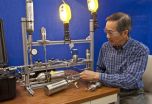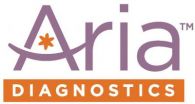(Press-News.org) Developments by hydrogen researchers at the U.S. Department of Energy's (DOE) Savannah River National Laboratory (SRNL) are paving the way for the successful development of portable power systems with capacities that far exceed the best batteries available today. SRNL's advances in the use of alane, a lightweight material for storing hydrogen, may be the key that unlocks the development of portable fuel cell systems that meet the needs for both military and commercial portable power applications.
SRNL has demonstrated a practical path to portable power systems based on alane and similar high capacity hydrogen storage materials that provide the sought-after high specific energy, which means the amount of energy per weight. Their accomplishments to date include developing a lower-cost method of producing alane, developing a method to dramatically increase the amount of hydrogen it releases, and demonstrating a working system powering a 150 W fuel cell. Portable power equipment manufacturers are looking for systems that can provide specific energies greater than 1000 watt-hours per kilogram (Wh/kg); that's more than 2 to 3 times the capacity of the best primary lithium batteries today. "Higher specific energy means more energy per weight," said SRNL's Dr. Ted Motyka. "The goal is to provide sufficient energy to a system that is light enough to be carried by a soldier or used in unmanned aircraft and other applications where weight is a factor."
Hydrogen, at 33,000 Wh/kg, has the highest specific energy of any fuel, so it is a natural candidate to fuel such high-capacity systems. The challenge, however, has been developing a material for storing hydrogen with both the high capacity and the low weight needed for portable systems.
SRNL has been working for years on developing several light-weight, high capacity solid-state hydrogen storage materials for automotive applications. While most of these materials do not meet all the various requirements needed for automotive applications, many may be viable for small portable power systems.
One of the most promising materials is aluminum hydride, (AlH3) or alane. Alane, while not a new material, has only in the last few years been considered as a hydrogen storage material for fuel cell applications. SRNL researchers are among only a handful of researchers, worldwide, currently working with alane and beginning to unwrap its material and engineering properties.
Dr. Motyka, Dr. Ragaiy Zidan and Dr. Kit Heung, all of SRNL, led a team to characterize and optimize alane as a hydrogen storage material, develop a small hydrogen storage vessel containing alane, and demonstrate hydrogen release at delivery rates suitable for powering small commercial fuel cells. The results of that work are attracting interest from several commercial companies working in the area of portable power systems.
Alane is one of the classes of materials known as chemical hydrogen storage materials. Like metal hydrides, chemical hydrogen storage materials provide a solid-state storage medium for hydrogen. Unlike metal hydrides, however, chemical hydrogen storage materials, like alane, do not readily reabsorb hydrogen, so once their hydrogen is released the material must be chemically reprocessed to restore its hydrogen. An advantage of alane is its very high hydrogen capacities; it can store twice as much hydrogen, in the same volume, as liquid hydrogen, and can do so at the very high gravimetric capacity of 10 wt%. Alane also exhibits very favorable discharge conditions, making it one of the ideal chemical hydrogen storage materials.
Among the biggest challenges the team addressed were the limited amount of readily available commercial alane, and its high cost to produce – which could be significant impediments to widespread use. As part of this project, they initially developed a bench-scale system to produce the quantities of alane needed for experimental and optimization studies. This work led to the development of a new and potentially lower cost process for producing alane. "Our process overcomes some of the handicaps of traditional methods for producing alane," says Dr. Zidan. "This novel method minimizes the use of solvents, and is able to produce pure, halide-free alane."
Work led by Dr. Zidan also resulted in a process to increase the amount of hydrogen that can be extracted from alane. This two-step process was found to double the amount of hydrogen that can be liberated from alane using a traditional one-step process.
A major part of this project was to evaluate alane systems for compatibility with small fuel cell applications. Preliminary results on a proof-of-concept vessel containing approximately 22 grams of alane showed that the system could scale nicely to meet the required hydrogen release rate for a small 100-watt fuel cell system. Based on those results a larger system containing 240 grams of alane was designed, fabricated and tested with a 150 watt commercial fuel cell. The results show that the system was able to operate the fuel cell at near full power for over three hours and at reduced power for several more hours.
INFORMATION:
Work to date was funded under SRNL's Laboratory Directed Research & Development program, which supports highly innovative and exploratory research aligned with the Laboratory's priorities. The success achieved so far has attracted additional funding from the DOE's Fuel Cell Technologies Program in the Office of Energy Efficiency & Renewable Energy, along with interest from commercial firms.
SRNL is DOE's applied research and development national laboratory at SRS. SRNL puts science to work to support DOE and the nation in the areas of environmental stewardship, national security, and clean energy. The management and operating contractor for SRS and SRNL is Savannah River Nuclear Solutions, LLC.
SRNL research paves way for portable power systems
2012-01-09
ELSE PRESS RELEASES FROM THIS DATE:
In the brain, 'ORMOSIL' nanoparticles hold promise as a potential vehicle for drug delivery
2012-01-09
BUFFALO, N.Y. -- In the images of fruit flies, clusters of neurons are all lit up, forming a brightly glowing network of highways within the brain.
It's exactly what University at Buffalo researcher Shermali Gunawardena was hoping to see: It meant that ORMOSIL, a novel class of nanoparticles, had successfully penetrated the insects' brains. And even after long-term exposure, the cells and the flies themselves remained unharmed.
The particles, which are tagged with fluorescent proteins, hold promise as a potential vehicle for drug delivery.
Each particle is a vessel, ...
Security Solutions International Announces Speakers for its Annual Homeland Security Conference at the Gaylord Palms on November 5th-7th 2012
2012-01-09
This year's 7th annual Counter Terrorist Magazine's Homeland Security Professionals conference is taking place at the Gaylord Palms in Orlando, Florida and big demand to hear the speakers is expected. Professionals won't just be attending from Florida's law enforcement, homeland security, Fire, rescue and emergency management. Past years have seen representatives from as far afield as Saipan and everywhere in the USA and Canada. This year's theme is expected to also draw significantly from private sector security.
"We are developing the best line up for our conference, ...
Insulin therapy may help repair atherosclerotic lesions in diabetic patients
2012-01-09
Philadelphia, PA, January 9, 2012 – New research reveals that insulin applied in therapeutic doses selectively stimulates the formation of new elastic fibers in cultures of human aortic smooth muscle cells. These results advance the understanding of the molecular and cellular mechanisms of diabetic vascular disease. The study is published in the February issue of the American Journal of Pathology.
"Our results particularly endorse the use of insulin therapy for the treatment of atherosclerotic lesions in patients with type I diabetes, in which the induction of new elastic ...
East meets West to boost fertility
2012-01-09
Traditional Chinese medicine has long been used to ease pain, treat disease, boost fertility, and prevent miscarriage. Known in the Western medical community by its acronym TCM, these traditional remedies include herbal preparations and acupuncture. Now Tel Aviv University researchers have discovered that a combination of TCM therapy and intrauterine insemination (IUI) is a winning solution for hopeful mommies who are having trouble conceiving.
In the first study that measures the effectiveness of both herbs and acupuncture in combination with IUI infertility treatment, ...
GW researcher and colleagues identify environmental exposure to organochlorines may impact male reproduction
2012-01-09
WASHINGTON (Jan. 9, 2011) — Melissa Perry, Sc.D., M.H.S., professor and chair of the Department of Environmental and Occupational Health at the GW School of Public Health and Health Services and adjunct associate professor at the Harvard School of Public Health, led an observational study indicating that environmental exposure to organochlorine chemicals, including Polychlorinated Biphenyls (PCBs) and p,p'-DDE (the main metabolite of the insecticide DDT) can affect male reproduction. The research was published online on Dec. 21, 2011 in the journal Environmental Health ...
Spasticity gene finding provides clues to causes of nerve cell degeneration
2012-01-09
The discovery of a gene that causes a form of hereditary spastic paraplegia (HSP) may provide scientists with an important insight into what causes axons, the stems of our nerve cells, to degenerate in conditions such as multiple sclerosis.
In the Journal of Clinical Investigation today, an international team of scientists led by Dr Evan Reid at the University of Cambridge, and Dr Stephan Zuchner from the University of Miami, report that mutations in the gene known as 'reticulon 2' on chromosome 19 cause a form of HSP, a condition characterised by progressive stiffness ...
SmartCEO Honors E. Davon Kelly and NOVAD Management Consulting with the Future 50 Award
2012-01-09
Davon Kelly, CEO of NOVAD Management Consulting will be honored on January 26, 2012 when Washington's SmartCEO magazine honors its 'Future 50 Award' recipients. The SmartCEO/Clifton Gunderson Future 50 Award recognizes 50 area companies based on revenue and employee growth over a three-year period. This year's Future 50 companies boast $11.7 billion in collective revenues and manage more than 30,000 employees in the Greater Washington area.
NOVAD, founded in 2003, has rapidly grown to 15 full-time employees, augmenting its staff with 15 independent contractors. Since ...
Aria Diagnostics announces publication of first peer-reviewed data for new noninvasive prenatal test
2012-01-09
San Jose, Calif., Jan. 9, 2012 – Aria Diagnostics (formerly Tandem Diagnostics), a molecular diagnostics company, today announced publication of data supporting a directed, non-invasive approach to cell-free DNA (cfDNA) analysis in maternal blood for evaluation of two common fetal trisomies linked to genetic disorders. The results, assessing the detection of Trisomy 21 (associated with Down syndrome) and Trisomy 18 (associated with Edwards syndrome), were published online at http://onlinelibrary.wiley.com/doi/10.1002/pd.2922/full.
"Our ability to identify pregnancies ...
Wildlife Conservation Society announces new snake species
2012-01-09
NEW YORK (DATE) -- The Wildlife Conservation Society (WCS) announced the discovery of a spectacularly colored snake from a remote area of Tanzania in East Africa.
The striking black-and-yellow snake is called Matilda's horned viper. It measures 2.1 feet (60 centimeters) and has horn-like scales above its eyes.
The discovery is described in the December issue of Zootaxa. Authors of the study include: Michele Menegon of Museo delle Scienze of Trento, Italy; Tim Davenport of the Wildlife Conservation Society; and Kim Howell of the University of Dar es Salaam.
The ...
Study reveals enzyme function, could help find muscular dystrophy therapies
2012-01-09
Researchers at the University of Iowa have worked out the exact function of an enzyme that is critical for normal muscle structure and is involved in several muscular dystrophies. The findings, which were published Jan. 6 in the journal Science, could be used to develop rapid, large-scale testing of potential muscular dystrophy therapies.
The enzyme, called LARGE, adds a critical sugar chain onto an important membrane protein called dystroglycan. This sugar chain acts like a glue allowing dystroglycan to attach to other proteins and by doing so, reinforce cell membranes ...



